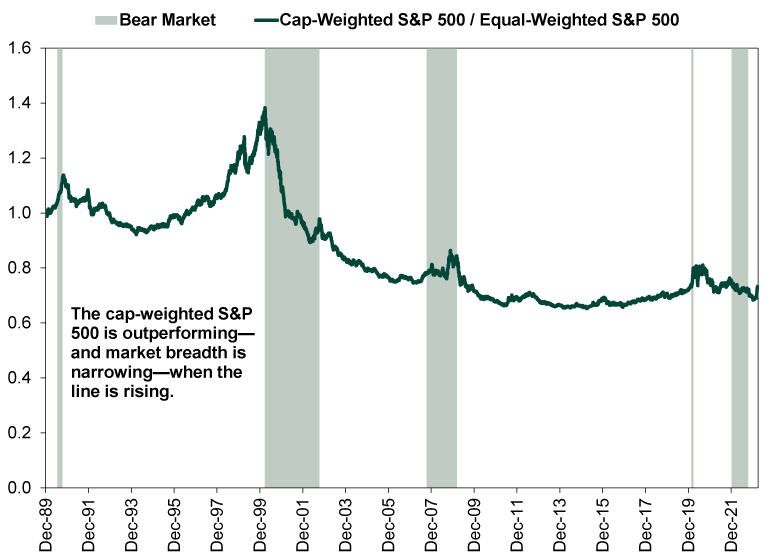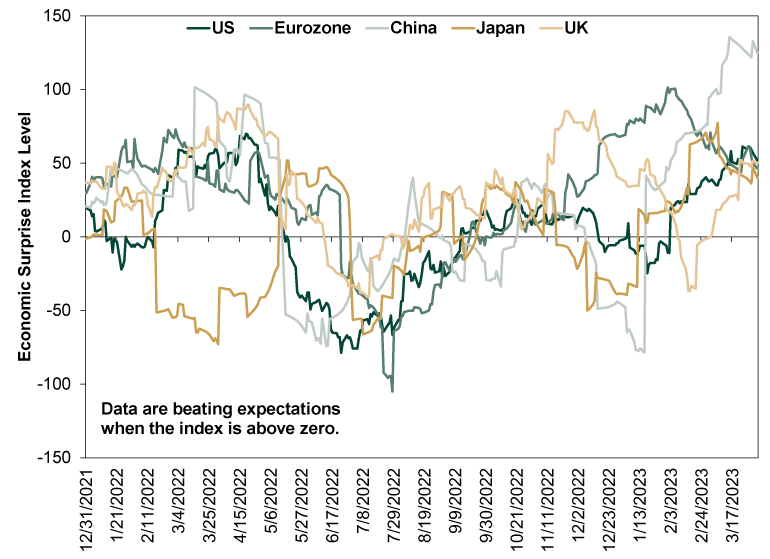Personal Wealth Management / Market Analysis
Ken Fisher’s ‘Pessimism of Disbelief,’ Illustrated
Sour sentiment and better-than-expected economic results are a normal bull market backdrop.
Amid all the din over March’s banking sector chaos, here is something that seems to have surprised many pundits: Stocks surged in the month’s second half, finishing it and Q1 with some pretty nice returns. The S&P 500 rose 7.5% in Q1, bringing its return since October 12’s most recent low to 15.8%.[i] The MSCI World Index did even better, up 7.7% and 18.8%, respectively, in those two timeframes.[ii] But sentiment hasn’t caught up. Surveys and a quick tour of financial headlines show people continue dismissing the rally and seeking reasons to be bearish. Meanwhile, economic data, while not stellar across the board, keep beating expectations. This is encouraging—a backdrop that makes today’s environment look more and more like the normal backdrop for stocks early in a bull market.
Until and unless stocks eclipse their prior peak, returns alone won’t tell you if a new bull market is underway. False dawns are common, and bear market rallies can get pretty big—as last spring and summer proved. Assessing sentiment can help a lot on this front. If a rally from a market low attracts plenty of cheer, it has a higher likelihood of being a fakeout—it would indicate sentiment hadn’t run its full bear market course to its typical ultra-pessimistic trough. New bull markets, by contrast, are usually unloved and disbelieved—a phenomenon Fisher Investments Founder and Executive Chairman Ken Fisher calls “the pessimism of disbelief.”
That sums up sentiment now, in our view—and not just the revolving fears over banks, Fed rate hikes, oil prices, the debt ceiling and more. A CNBC survey of Wall Streeters found 70% of the “chief investment officers, equity strategists, portfolio managers and CNBC contributors who manage money” expect stocks to fall from here.[iii] Just over one-third called Fed error the biggest risk, and another third cited inflation—basically overlapping fears, considering how many associate inflation with more rate hikes … and rate hikes with bear markets. Only 32% said the low is nearby or in the rearview. When asked their preferred “safe haven,” 59% said cash, indicating last year’s bond market woes have the pros similarly skittish toward fixed income.
Some are reaching for technical reasons to argue the rally is a mirage. One piece that got a fair amount of attention Friday argued that while the S&P 500 is up, relatively few stocks are driving it—market breadth is too low, if you will pardon the technical term. With the equal-weighted S&P 500 index several points behind the headline market-cap weighted index in the quarter, returns must be coming from just a handful of companies hiding dim results among the vast majority of stocks. In other words, if most companies aren’t up, then the rally isn’t real.
A look at market history should put this to bed. Exhibit 1 shows the cap-weighted S&P 500’s returns relative to the equal-weighted since daily total return data for the latter begin in 1989. When the line is rising, the cap-weighted index is outperforming, indicating narrower market breadth. As you will see, little wiggles early in a bull market aren’t unusual, and the most recent little bump isn’t out of step with those that came before. (For visual clarity, we ended the 2022 bear market shading at the October low, although we cannot know for sure if that is the ultimate low yet.)
Exhibit 1: Market Breadth Isn’t an Ironclad Indicator

Source: FactSet, as of 3/31/2023. S&P 500 and S&P 500 Equal-Weighted Index total returns, 12/31/1989 – 3/30/2023.
Moreover, breadth doesn’t have a standard bear market pattern. It narrowed in 1990’s short downturn but mostly widened during the dot-com bust. It went back and forth during the global financial crisis and widened irregularly during 2022. (The COVID bear market is too short to glean any meaningful trends from, in our view.) About all we can say is that breadth usually narrows as bull markets mature—which is consistent with the tendency for the biggest stocks to lead later in the cycle—but that doesn’t mean it can’t narrow at times early on.
So sentiment and market behavior are pretty standard for an early bull market. Crucially, so are economic drivers. As we have often said, new bull markets don’t need perfection—just a reality that goes modestly better than expected. That is the power behind pessimism—it lowers the bar to clear after the bear market destroys sentiment and darkens expectations … and reality has been clearing it. Citi’s Economic Surprise Indexes are a handy, if imperfect, way to see this, and they show a mild upward trend in data beating expectations across global markets. Headlines dwell on high-profile misses like manufacturing purchasing managers’ indexes and US retail sales, but these are the exceptions, not the rule, as Exhibit 2 shows.
Exhibit 2: Positive Surprise Is Trendy

Source: FactSet, as of 4/3/2023.
With all this said, it remains possible that this is an unloved bear market rally. Time will tell. But investing is about probabilities, not possibilities or certainties. To us, the probability that a new bull market is either very close or underway looks quite high, making the risk of being on the sidelines and missing bull market returns greater than the risk of being in and enduring a bit more downside.
[i] Source: FactSet, as of 4/3/2023. S&P 500 total returns, 12/31/2022 – 3/31/2023 and 10/12/2022 – 3/31/2023.
[ii] Ibid. MSCI World Index returns with net dividends, 12/31/2022 – 3/31/2023 and 10/12/2022 – 3/31/2023.
[iii] “Investors Believe the Stock Market Is Set for Losses, and Cash Is Best Safe Haven, CNBC Survey Shows,” Yun Li and Patricia Martell, CNBC, 3/31/2023.
If you would like to contact the editors responsible for this article, please message MarketMinder directly.
*The content contained in this article represents only the opinions and viewpoints of the Fisher Investments editorial staff.
Get a weekly roundup of our market insights.
Sign up for our weekly e-mail newsletter.

See Our Investment Guides
The world of investing can seem like a giant maze. Fisher Investments has developed several informational and educational guides tackling a variety of investing topics.








